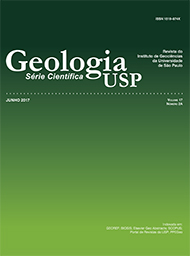Damage mapping of the stones of Imperial Palace, Rio de Janeiro
DOI:
https://doi.org/10.11606/issn.2316-9095.v17-305Keywords:
Imperial Palace, Geoconservation, Weathering.Abstract
The Imperial Palace is a building of the colonial period, located in the center of the city Rio de Janeiro and with historical and cultural value. For its construction, in the 18th century, two types of gneiss were used and they came from the quarries of the city. The first is a gneiss with ophthalmic structure given by megacrystals of microcline and granitic matrix, while the second gneiss has a quartz-feldspar composition, with slight banding and often, massive texture. Traditionally these rocks are called facoidal and leptinitc gneiss, well known by professionals in the conservation of the built heritage in the city. Besides these gneisses, the lioz limestone was also extensively used in internal and external facades as ornaments around the doors and windows. On a much smaller volume, a gray granite with thin equigranular texture was identified in one of the facades, probably comes from the city, but its geological unit was not recognized. Studies about the weathering of these gneisses have been published, but little is known about the degradation of these rocks in the built environment and urban city of Rio de Janeiro, with application to the conservation of cultural heritage. This paper presents an evaluation of the degradation of the rocks described, based on field mapping, according to the recommendations of International Council on Monuments and Sites (ICOMOS) and processing of data in the ArcGis10 tool. The main forms of damage identified were discoloration, black crust, missing part and exfoliation. Chemical analysis of the washed water from the surfaces of rocks showed that the main component is sulfur. The results of this study are relevant to assist in the conservation of this important heritage.
Downloads
Downloads
Published
Issue
Section
License
Authors who publish in this journal shall comply with the following terms:
- Authors keep their copyright and grant to Geologia USP: Série Científica the right of first publication, with the paper under the Creative Commons BY-NC-SA license (summary of the license: https://creativecommons.org/licenses/by-nc-sa/4.0 | full text of the license: https://creativecommons.org/licenses/by-nc-sa/4.0/legalcode) that allows the non-commercial sharing of the paper and granting the proper copyrights of the first publication in this journal.
- Authors are authorized to take additional contracts separately, for non-exclusive distribution of the version of the paper published in this journal (publish in institutional repository or as a book chapter), granting the proper copyrights of first publication in this journal.
- Authors are allowed and encouraged to publish and distribute their paper online (in institutional repositories or their personal page) at any point before or during the editorial process, since this can generate productive changes as well as increase the impact and citation of the published paper (See The effect of Open Access and downloads on citation impact).





